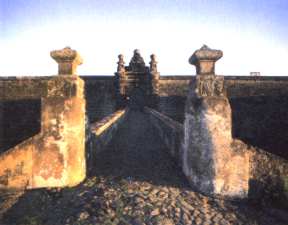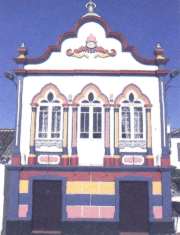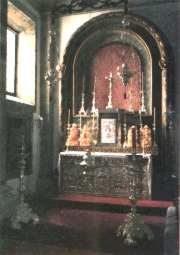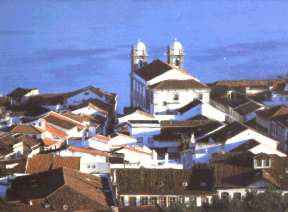|
|
|
|
WORLD HERITAGE SITES IN PORTUGAL
ANGRA DO HEROISMO
HISTORICAL CENTRE OF ANGRA DO HEROISMO
Until the fifteenth century, it was the inward-looking Mediterranean sea that was used for trade between the peoples of Europe and the Levant. Beyond this space was an enormous expanse of sea that still remained to be discovered, its full extent unclear and perhaps inhabited by terrible and mythical creatures. Situated at the furthest extremes of the European continent and bordered to the west and south by the unknown Atlantic, Portugal and the Portuguese were inevitably the first to venture forth upon the ocean. Their first voyages took them along the west coast of Africa, allowing them to perfect their navigation techniques, which until them had been limited to Mediterranean conditions, to learn more about the winds and set off in other directions. In 1427, at a distance of roughly 1500 km from the European continent, the first Portuguese caravels discovered the archipelago of the Azores, which was soon to play such an important role as a commercial port and cultural bridge between the Old and the New Worlds. And, in this group of nine islands, Angra do Heroísmo, the port on the island of Terceira came to be of such major strategic significance in the context of the great maritime discoveries that in I983 the central area of the city was quite justly added to UNESCO's list of world heritage sites.
In the fifteenth century it was certainly not very easy or comfortable to sail across the ocean between Lisbon and the Azores in those small caravels, but nowadays all that it takes is a two-hour plane trip.

You should begin your visit by climbing to the top of Monte Brasil. From the highest Point of this promontory, you can enjoy a superb panorama over the natural amphitheatre of the city and will certainly begin to understand why the Portuguese navigators chose to build their first settlement on this site, protected from the prevailing winds by a series of hills and with two natural harbours, separated by the isthmus that connects Monte Brasil to the rest of the island. Faial to the west is open to the sea and therefore more exposed to the elements; Ancoragem (Angra) is more sheltered from the wind and it was this bay that gave the city its name. It is here that the castle stands, originally with the name of Sao Filipe, because it was built in the reign of Philip II, the Spanish king who had simultaneously occupied the thrones of both Spain and Portugal, when the latter was left vacant by the Cardinal-King D. Henrique, who died without leaving any heirs.This formidable, vigilant and most effective fortress encircles Monte Brasil with its 4 kilometre-long wall and its 400 pieces of artillery that protected the ships returning from the West Indies laden with gold and silver or from the even more distant India with their cargoes of exotic spices. The enormous size of this fortress clearly expresses the true dimensions of a powerful peninsular empire united by the Atlantic shipping routes that were themselves connected through this archipelago to the very heart of the kingdom.

The Igreja de Sao Joao Baptista stands in the castle's parade ground, built in memory of the Restoration of Portuguese sovereignty in 1640, after which the fortress was baptised once more with the name of the church. At the other end of the Baia de Angra, opposite the Porto de Pipas, is the Castelo de São Sebastião, built in the sixteenth century at the orders of the king D. Sebastião. Its fire was crossed with that of another three small forts along the coastline from Monte Brasil, thus creating an invincible defensive system for the port, which had been a favourite target for the many pirates who knew of the great treasures that passed through it.From this same viewpoint, with the city of Angra lying below you at your feet, you will see the intersection of the city's two main streets: Rua da Se and Rua Direita, around which, like a chessboard, an interconnecting urban grid has developed, strangely devoid of the mediaeval roots normally seen in the large European cities. This simple geometry made it possible for cities to grow in such a way that they could easily absorb new waves of settlers beyond their existing limits. Amongst some of the most notable features of the city's civil architecture is a series of eighteenth and nineteenth-century buildings, very similar to the houses from the colonial period that are to be found in Brazil, particularly in São Salvador da Baía, a city which is twinned with Angra.
In relation to the city's religious architecture, it is a remarkable fact that, at one stage, Angra had as many as nine convents, each with its own cloisters, walls and churches. Most of these churches are from the mannerist and baroque periods and are remarkably grand if we bear in mind the poor quality of the stone to he found on the island. The interior decoration of these churches relied on the use of both the traditional carved and gilded woodwork and the rich and exotic woods of Brazil. As well as these monumental churches, the visitor's attention is also drawn to a number of smaller chapels with large and sometimes bright coloured windows, surmounted by a closed crown. These are the impérios or “empires” of the Holy Ghost, which in their simplicity retain the symbolic memory of a universal empire, united by the tongues of fire that have made communication and solidarity possible between men.
Besides this emblematic and distant significance, there are also churches with a continuing and lively tradition that naturally derives from such a profoundly popular cult. The festival of the Divine Holy Ghost, a characteristic feature of the whole of Terceira island, runs from Whit Sunday to the end of the summer, always enlivened by the typical soups of the Holy Ghost, accompanied by different varieties of bread, served as a symbol of the generous distribution of food amongst the most needy. The festivities are a time of happiness, with much singing and dancing, and end with the “touradas a corda”, a popular form of bullfighting that provides a unique spectacle you cannot afford to miss.

After walking down from Monte Brasil into the town, you should begin your visit in Rua do Santo Espirito - named in fact after the Holy Ghost - which starts by the shore of the bay. Here you will find the baroque Igreja da Misericórdia, which contains some very interesting paintings and sculptures from that period. Further on is the imposing nineteenth-century building of the ''Pacos do Concelho'' or Town Hall. Continue your visit along the Ladeira de Sao Francisco and you will come to the Igreja da Nossa Senhora da Guia, where the seafarer Paulo da Gama is buried, who accompanied his brother Vasco da Gama on his first sea voyage to India in I497. The church's interior is an outstanding example of that art which is exclusive to the Portuguese: the combination of the gold covering placed on the carved woodwork with the blue of the azulejos that line the walls.A little further ahead, housed inside the former Convento de Sao Francisco (to which the Igreja da Guia used to belong), is the Museu de Angra. This museum tells the story of the city and has a particularly impressive collection of sixteenth-century paintings. Not far from here, in Largo Prior do Crato, a sixteenth-century building - the Palacio dos Capitaes Generais - is intimately linked to the history of the Azores. This was originally the Jesuit College, before it was abandoned in 1759. When the General Captainship was created in 1766, the building was converted into the residence of the Captain-Generals, who ruled over the military, political and administrative life of the archipelago.
The inside of the building has a rich and extremely beautiful decoration, with furniture from the seventeenth and eighteenth centuries, porcelain from the East India Company, painting, sculpture and some delightful examples of the goldsmith’s art. Close by is the cathedral (from the sixteenth and seventeenth centuries), which also reveals to us a little of the history of Angra in its use of exotic woods and inlays, its carved silver and it sacred art objects. Other similar riches can be seen in the church of the Jesuit College and the Igreja de Sao Goncalo, in the immediate vicinity of the cathedral. The Palacio dos Bettencourts is a beautiful seventeenth-century building, which now houses the public library and the city archives, with more than 400,000 books and two million documents!

On returning to the Baia de Angra, we suggest that you take a pleasant stroll through the Porto de Pipas, famous for its historical connections with caravels and galleons, and through the streets where the oldest manor-houses are to be found (Solar dos Cortes Reais and Solar dos Cantos), evocative of the early days of the island's settlement. A climb up to Alto da Memoria, on the opposite side, allows you to enjoy a view of Monte Brasil, the point where your tour began, as well as the city of Angra do Heroísmo against the backdrop of the sea that has lain behind all of its history. It was here, at Alto da Memoria, that the first castle was built in the archipelago, with the still mediaeval aim of providing a defence against invaders from the sea and watching over the wheat-fields around.Finally, the visitor may wonder how the word ''Heroísmo'' came to be included in the name of the city. This title was justly bestowed upon the city of Angra by the Queen D. Maria II in the nineteenth century in recognition of the bravery and sacrifice shown in the struggle that ended with the implantation of Liberalism in Portugal.
No visitor can come to Angra without also leaving the city to travel around this small island and revel in its green bucolic landscape, interrupted here and there by small lagoons, and full of panoramic views over broad horizons, as well as caves and natural swimming-pools. As in the rest of the Azorean islands, it is still possible here to appreciate and experience the long-lost harmony between man and nature.
Text provided by the Portuguese Tourist Office